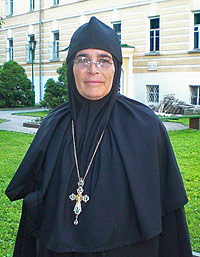
Holy Trinity Monastery was founded by Mother Ines and Sister Maria Amistoso in April of 1986. In 1989, the engineer Federico Bauer donated a piece of land on the shores of Lake Amatitlan, not far from Guatemala City, to the monastery. The land is 1188 meters [about 3900 feet] above sea level and is located near Pacaya, one of the most active volcanoes in Central America.
On the day of St. Nicholas the Wonderworker in 1995, the “Act of Creating an Orthodox Church in Guatemala” was signed by Bishop (now Metropolitan) Antonio Chedraoui of Mexico, Venezuela, Central America and the Caribbean (of the Antiochian Patriarchate), and also by the head of the monastery, Mother Ines and her nuns, and 25 parishioners.
Buildings rose on the site donated by Federico Bauer and the consecration of the monastery took place in November, 2007, with 18 participating clerics, who came to Guatemala especially for this occasion.
The iconography in the Monastery church is being done by Russian masters from the International School of Icon Painting, based both in the town of Kostroma in Russia and in the USA.
In 1996, the government of Guatemala gave the monastery control of an orphanage built to house 800 children, the “House of Rafael Ayau” in the country’s capital, Guatemala City. At present they have just over 100 boys and girls – from newborn babies to 16 year old adolescents. The workers at the orphanage give the children a high-school education and familiarize them with basic Orthodox concepts. They also give them professional skills. Soon, the orphanage will be moved to the monastery.
In February of 1997, the church of the Transfiguration of the Lord was blessed in the orphanage building. In the absence of a priest, the services are led by a reader [called Reader’s Services]. Two children’s choirs sing antiphonally, where one choir sings one stanza, and then the other choir sings the next stanza. The exclamations and the dismissal are read by Mother Ines. The parish is made up of Guatemalans, Arabs, Greeks, Russians, and Ukrainians.
Holy Trinity Monastery has fairly large agricultural holdings, where rabbits and fish are raised and vegetables are grown. All that they produce goes to the orphanage.
In July of 2009, Mother Ines came to Russia to visit the holy places and to broaden her ties to the Russian Orthodox Church. The Abbess was accompanied Sister Maria and two teenagers from the orphanage.
This conversation with Mother Ines took place during that visit, on a trip from Sretensky Monastery to the Holy Trinity-St. Sergius Lavra. [lavra: a large monastery]
– Mother Ines, how did you become acquainted with the Orthodox faith?
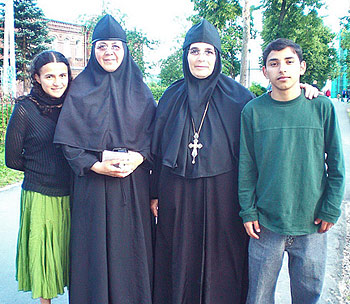 Abbess Ines, Sister Maria, and two of the “graduates” of the orphanage, Reina and Edgar Rolando
Abbess Ines, Sister Maria, and two of the “graduates” of the orphanage, Reina and Edgar Rolando I studied theology for ten years – with the Salezians in Guatemala, with the monks of the Holy Spirit in Mexico, with the famous theologian Jean Daniélou in France, and with the Jesuits in Belgium and El Salvador. I continued to be bothered by one question: where are the treasures to be found that I came across at the beginning of my Monastic life? Once, in Brussels, the nun who was in charge of my spiritual growth brought me to a Russian Paschal [Easter] service. It was held in a chapel on the second floor of a private home, but even then, I did not find an answer to my question.
I did not want to serve in Latin America: in those years, because of the spread of “liberation theology”, Church-government relations had become seriously strained. I received permission to go to the Philippines. There, to my amazement, I met more Sisters of the Dormition, who were seeking the same thing I was. We found out about Eastern Rite Catholics, and considered reforming our community to use the Eastern Rite. Unfortunately, most of the Sisters left, and several got married. Only the native-Philippine Sister Maria and I remained. The nuns of my order, which has great influence in the Philippines, asked me to leave the country, because they thought I was spreading revolutionary sentiments.
I went to Jerusalem, where I finally came into contact with real Orthodoxy. Sister Maria came to me from the Philippines, and together we traveled across the Holy Land, started to learn different liturgical services, and talked to priests.
– How did your family take your conversion to Orthodoxy?
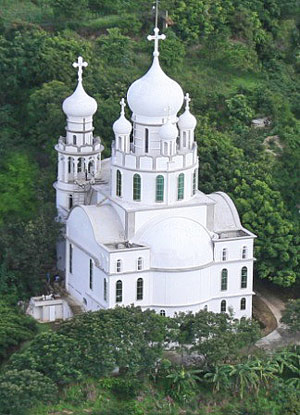 The katholikon of the Monastery of the Holy and Life Giving Trinity, the “Lavra of Mambre”
The katholikon of the Monastery of the Holy and Life Giving Trinity, the “Lavra of Mambre” My mother supported my decision right away. She was interested in Russia, and read a lot about it. She read a book about the activities of the Russian Orthodox Church in Alaska with great interest. When the Antiochian Bishop Antonio Chedraoui, during his first visit to Guatemala, received some Arabs into Orthodoxy, my mother also went forward and was received into the Orthodox Church through chrismation. Later, my father also became Orthodox.
– How did you join the Antiochian Church?
– Sister Mary and I decided to form an Orthodox monastery in Guatemala. On our way from Israel, we stopped in the Swiss town of Chambésy [not far from Geneva], where we visited Metropolitan Damaskenos Papandreu of Switzerland (Patriarchate of Constantinople). He blessed the opening of our Monastery, and said that we had to join a jurisdiction of one of the Orthodox patriarchates. To do this was not easy. The Orthodox Churches that had a presence in Latin America then did not have a particular interest in the local population. The Patriarchate of Constantinople served the Greeks, the Patriarchate of Antioch – Arabs, the Russian Patriarchate – Russians. Only after asking for ten years did we get accepted by the Antiochian Church’s Metropolitan Antonio (Cherdaoui).
For the registration of a parish, we needed 25 signatures of Guatemalan citizens. We did not have that many parishioners. So my relatives, the relatives of another nun, Sister Ivonne, and our friends also signed the petition.
– Why did your community choose the ancient Russian style when building your church?
– We sincerely love Russia and the Russian Orthodox Church. The crosses on our cupolas are Byzantine, but everything else is Russian: the architecture, the icons, and the frescos. People, when they see the Russian cupolas, understand right away that there is an Orthodox church before them. Our parish keeps to Russian traditions in the services, keeps to the Julian calendar; and the nuns wear the Russian monastic habit.
– Where is the monastery?
– We built the monastery 20 kilometers [about 12½ miles] from Guatemala City, on the top of a hill. Around us there are woods, and not far away, Lake Amatitlan. It is a very beautiful place, although it’s true that it is not entirely fitting for a holy monastery because we are so close to the city and come across the problems that exist in any suburb of a large Latin American city–overpopulation and the drug trade.
–How large is the Sisterhood?
– Three nuns live in the monastery. Besides me, there is Sister Maria Amistoso, who is a native of the Philippines, and Sister Ivonne Sommerkramp who came to the monastery five years after it was founded. She is a Guatemalan with German roots. Earlier, we had more nuns.
– Who performs services?
– We do not have a permanent priest yet. Two times a month, groups of missionaries and volunteers come from places such as the USA, Norway, Japan and other countries; and those groups always have a priest. Russian priests have also been with us: Protopriest Basil Movchanuk – head of the church of Sts. Peter and Paul in Yartsevo, in the Smolensk region; and Protopriest Igor Kropochev – a helper for the missionary department of the Kemerovo diocese.
–Tell us about the monastery’s orphanage please.
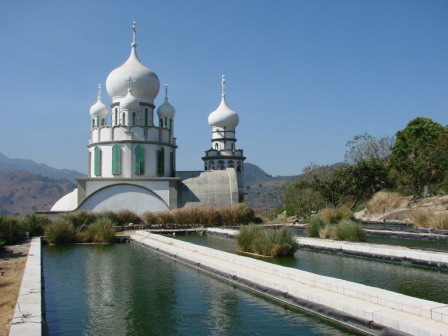
Because of changes in the social laws, our orphanage began to look more like a boarding school. In twelve years, over 1000 children from poor and underprivileged families have gone through our orphanage. All of them are raised in the Orthodox spirit. Many of them return to their parents, but do not break their ties to the monastery, and continue to go to liturgy on Sundays. Over 300 of our orphans have been adopted by Orthodox families, mostly in the USA.
The Russian ambassador to Guatemala, Nicholas Vladimir, had told me that the Russian government grants stipends for higher education in Russia to young people from other countries, and we have taken advantage of that opportunity. Two of our children, Reina and Edgar Rolando, have come with us to Moscow. They will start studying Information [Computer] Science and Engineering at a Russian university in September.
– How are your monastery’s relations with the Catholic Church?
– We have a warm, friendly attitude towards them, but the Catholic Church has been quietly waging war against us, warily, secretly. For example, after we sent our petition to register the parish with the [Guatemalan] Ministry of Foreign Affairs, we did not know what happened to it for several years. When President Arsu asked the monastery to take the orphanage under its wing, I said that we could not do it, because we did not officially exist. The President entrusted his lawyer with solving the problem. As it turned out, our documents had been located in the curia the entire time; Catholics had spirited them away. Fortunately, President Arsu then gave the Holy Trinity Parish the status of a jurisdictional body by special decree.
Protestant denominations, of which there are hundreds now, do not worry the Catholics. Orthodoxy puts fear into them. There are several reasons for this, but, the biggest reason is that the Catholic hierarchy fears that the Orthodox Church will convert some of their flock. The Cardinal of Guatemala admitted this to the Russian ambassador.
Nonetheless, it is impossible to escape contact with the Catholic Church. Catholicism dominates Guatemala. My father is a public person; I was a Catholic nun for 16 years; the Cardinal is the cousin of my godfather, and has known me since childhood.
–What are Orthodoxy’s prospects in Guatemala, in your opinion?
– I am convinced that Orthodoxy has a great future in our country. Two priests, one 20 years ago, and another recently, [unofficially] converted to Orthodoxy from Catholicism, and brought their flocks with them. In total, that is over 100,000 people. They consider themselves Orthodox, though they have not been officially joined to the Orthodox Church, and, from my observations, know very little of Eastern Christianity. Among them are Ladinos (descendants of the Spanish) and Indians. Both groups intend to ask for entrance into the Russian Orthodox Church.
– What are your impressions of Russia from your visit?
– I have no words to describe the feelings that I have when I am here. I am astonished by everything: the architecture, and the interior decoration of the churches and monasteries, the architecture of the cities and towns, the nature [flora and fauna]… I especially notice the piety of the people, their deep faith, which they have preserved through decades of the godless Communist regime.
Interview conducted by Miguel Palacio.
Translated into English by Adrian Fekula. Translation edited by Br. James Hazen



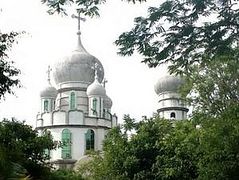
I enjoyed reading your interview with Pravoslavie.Ru
I think that it is wonderful to see Latin American
people seeking Orthodoxy.I hope that many more people
will come to the faith,with the life and witness of Madre
Ines. Thank you very much. Yours in Christ Ponomar
Jose.